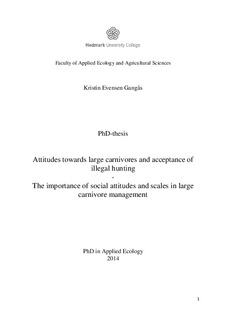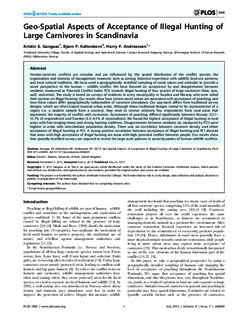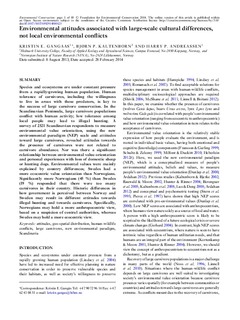| dc.contributor.author | Gangås, Kristin Evensen | |
| dc.date.accessioned | 2014-05-14T09:27:44Z | |
| dc.date.available | 2014-05-14T09:27:44Z | |
| dc.date.issued | 2014-05-14 | |
| dc.identifier.uri | http://hdl.handle.net/11250/194991 | |
| dc.description | PhD in applied ecology | nb_NO |
| dc.description.abstract | Human population growth is escalating, threatening the conservation of wildlife and natural wildlife habitats as we face a growing demand for natural resources and areas for human land use. Wildlife managers cannot focus solely on ecological issues when managing wild species, but have to include humans in their decision making. Moreover, they have to deal with social perspectives such as local cultural traditions, people’s acceptance of wildlife species and historical experience with wildlife in their landscape use.
In this thesis I have used geographical stratified sampling to map people’s attitudes towards large carnivores, people’s environmental value orientation, and the potential social conflict between people with regard to their acceptance of illegal hunting of carnivores. I have done this on a spatial scale related to predictors that have been shown to affect people’s tolerance of carnivores. These include the distribution of carnivores, livestock farming and local hunting traditions. I have also reviewed the literature to see how illegal hunting differs globally between continents, both in what motivates illegal hunting and how the species exploited vary between continents. I have also studied how scaling in social sciences is not always well matched with ecological scaling, and discuss how management decisions made at a scale that suits public opinion, does not necessarily benefit ecological sustainability.
I found no correlation between carnivore presence and attitudes towards carnivores. Acceptance of illegal hunting was higher in areas with rural social values associated with big game hunting and free ranging sheep grazing. The potential for social conflict showed a positive correlation with the acceptance of illegal hunting and was highest in areas with intermediate human population densities. Respondents with pro-environmental values revealed a lower acceptance of illegal hunting and greater tolerance of carnivores than people with a more negative environmental value orientation.
There were clear spatial differences in the motivation for illegal hunting. Recreational Hunting and Harvesting was found to be the most commonly reported rationale for illegal hunting within all continents except Africa and Latin America. Trade was the second most reported rationale and associated with areas containing high biodiversity, while Bushmeat tended to be most common in continents with low Gross Domestic Product (GDP). Herbivores were the most reported species exploited illegally in all continents, generally followed by carnivores, while the exploitation of fish, sea mammals, primates and birds differed to a much greater extent, both between continents and with rationale.
When discussing the expressed mismatch in the spatial scale of ecological processes and social structures, my results show that certain attitudes are related to local spatial scales (e.g. feelings of fear), while tolerance to carnivores in general was associated with a broader scale (national level). For large carnivores it would be ecologically preferable to establish a common Scandinavian management model, but this has the potential to exacerbate social conflicts.
My work contributes to an increased understanding of how human’s acceptance of wildlife, together with an awareness of the social and ecological scales, should be taken into account to ease conflicts in wildlife management. This may enable better conservation of species and habitats in the future, not only when it comes to large carnivores on the Scandinavian Peninsula, but global wildlife management in general. | nb_NO |
| dc.language.iso | eng | nb_NO |
| dc.relation.ispartofseries | 2-2014;PhD in applied ecology | |
| dc.relation.haspart | Paper 1: Gangaas, K.E., Kaltenborn, B.P. & Andreassen, H.P. (2013) Geo-Spatial Aspects of Acceptance of Illegal Hunting of Large Carnivores in Scandinavia. PLoS ONE 8(7): e68849. doi:10.1371/journal.pone.0068849 | nb_NO |
| dc.relation.haspart | Paper 2: Gangaas, K.E., Kaltenborn, B.P. & Andreassen, H.P. (2013) Environmental attitudes associate with large-scale cultural differences, not to local environmental conflicts (In press Environmental Conservation) | nb_NO |
| dc.relation.haspart | Paper 3: Gangaas, K.E., Kaltenborn, B.P. & Andreassen, H.P. (2013) Global differences in the motivation for illegal hunting (Submitted Conservation Biology) | nb_NO |
| dc.relation.haspart | Paper 4: Andreassen, H.P., Gangaas, K.E. & Kaltenborn, B.P., (2013) Matching social-ecological systems by understanding the spatial scale of environmental attitudes (Submitted Biological conservation) | nb_NO |
| dc.subject | large carnivores | nb_NO |
| dc.subject | attitudes | nb_NO |
| dc.subject | illegal hunting | nb_NO |
| dc.subject | illegal jakt | nb_NO |
| dc.subject | store rovdyr | nb_NO |
| dc.title | Attitudes towards large carnivores and acceptance of illegal hunting : the importance of social attitudes and scales in large carnivore management | nb_NO |
| dc.type | Doctoral thesis | nb_NO |


